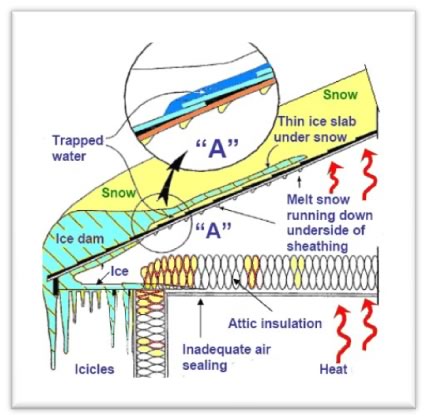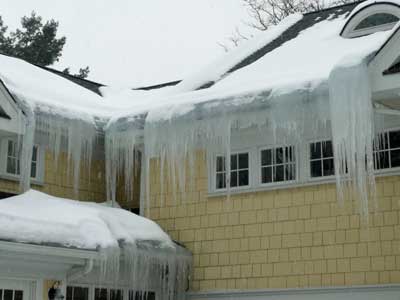During these cold winter months, it is common for us to get several calls a day about leaking roofs. Homeowners will find water spots on the ceilings, typically in a bathroom, and assume there is a leak in the roof. However, if you didn’t notice water spots or leaks in the ceiling during the rains of Spring and Summer, chances are good that you may have an ice jam, not a leaking roof.
Problems associated with ice jams or ice backups usually appear in bathrooms. The plumbing stack develops frost when the temperatures dip below freezing, and that frost can melt after heat from a shower rises. Brown water marks around canned lights and vent fans will appear after this freeze/thaw cycle, leading to concerns about a leak in the roof. The bathroom vent is an additional source of condensation and contributes to the excess moisture.
Proper attic insulation and soffit ventilation is likely the problem. Air should go into soffits and out the roof, but when there are not enough soffit vents, or the vents become plugged, ice backups can occur. Vents can become plugged with insulation, cotton from trees, or paint, and they can essentially start to act like a vacuum, sucking in moisture from the snow.
There are a few simple steps that can help you avoid ice jams in your roof:
· If your attic is unfinished, check to see if you can see light from the outdoors. If you are unable to see light, your soffit vents may be plugged
· Keep gutters and vents clean of visible debris
· Use a vent calculator to determine if you have an adequate number of vents
· Replace vents with newer vents that don’t get plugged as easily
· The attic should have a few feet of insulation. If you are unsure if your home has enough insulation, have a contractor check it out
· Watch for icicles to form – they can be an indication of an ice jam
Keep in mind a general rule of thumb – if your roof wasn’t leaking in the rain, the water spots you see in the winter are more than likely an indication of an ice jam or backup. If you are concerned, give us call!



